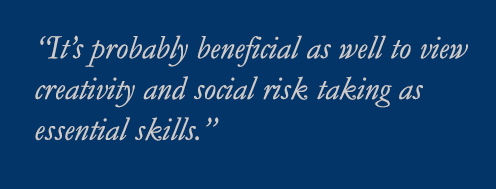As the years pass, do we tend to become more risk averse? Do we seek out the sure thing, preferring to avoid the doubtful and uncertain, the unusual or unsettled? Many come to view risk taking as something to be avoided, an unnecessary threat or hazard––after all, why take the chance? As the years pass, it’s easy to grow cautious, opting for the uncomplicated, the obvious, the straightforward. Many fall prey to this seemingly rational, risk-averse manner of thinking.
Risk taking as a mindset is one that’s typically not emphasized: parents and teachers do not encourage it; most institutions, social or business, prefer to avoid it; society itself tends to guard against it. But researchers are now finding out that risk taking is essential to creativity.
A recent article on creativity establishes a surprising link between creativity and social risk taking, concluding: “Our study demonstrates that individuals who possess a creative personality and mind-set are more likely to take risks exclusively in the social domain. These results thus highlight the importance of the role social risk taking attitudes play in creativity. The current research also emphasizes the need to investigate risk taking in a domain specific context. In our understanding, this is the first study to show that not only is creativity linked to risk taking, but also that this relationship is highly domain specific.”
It’s a bit surprising to learn that the most creative people tend to be those willing to take the greatest risks, not privately but publicly, within the social domain, in plain view, subject to the criticism and evaluation of others. “The results from this study demonstrated that social risk taking was the only statistically significant predictor of the measures of creativity. This provided support for our initial findings that creative individuals are more likely to take risks exclusively in the social domain.”
The stereotype of the creative person as a loner, an outlier, working in isolation has always appeared to be superficially plausible. But the reality is quite the opposite: the most creative people are those most willing to take risks in the social domain. “The results from the first study indicated that among the six domains of risk taking, only social risk taking shows strong evidence for correlations with CPS [Creative Personality Scale], ideation, and creative achievements. None of the other domains of risk taking, as measured by the gambling task and risk taking questionnaire showed a statistically supported correlation with any of the measures of creativity.”
In light of this, to encourage the creative habit, one’s practice should change from inner-directed to outer-directed. It’s probably beneficial as well to view creativity and social risk taking as essential skills. The more interesting question is why––why do the most creative people embrace social risk taking? Are the social aspects of creativity actually part and parcel of the creative process?
Creative people welcome risk: they routinely come up with new and practical ideas, and are more than willing to try them out. Lawyers in general should probably be a bit more inclined to embrace the mindset where risk taking is celebrated. Progress occurs when the new supplants the old––without risk taking, such cannot occur. “All of the aforementioned acts are risky since there is always some uncertainty associated with the social evaluations. These creative acts thus require individuals who are willing to take risks in the social domain.”
All quotations from: Vaibhav Tyagi, Yaniv Hanoch, Stephen D. Hall, Mark Runco, Susan L. Denham, The Risky Side of Creativity: Domain Specific Risk Taking in Creative Individuals, Front Psychol. 2017; 8: 145 (February 3, 2017)
https://www.ncbi.nlm.nih.gov/pmc/articles/PMC5289983/




